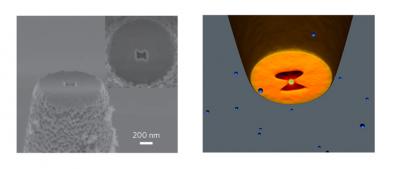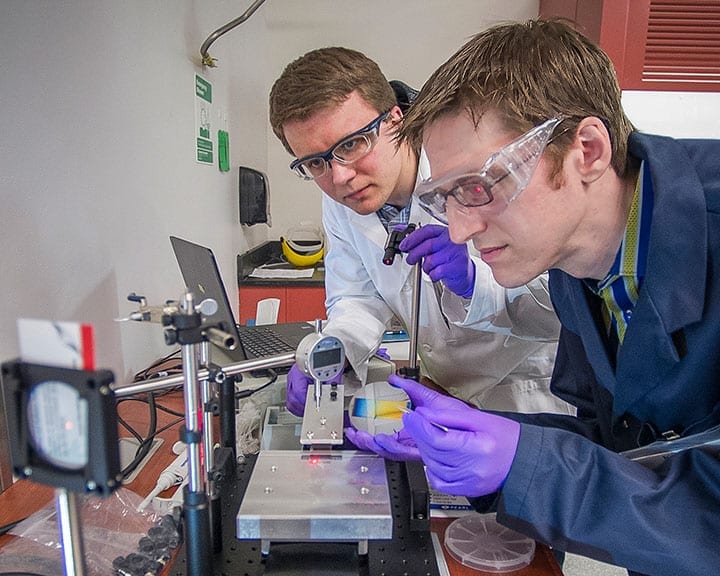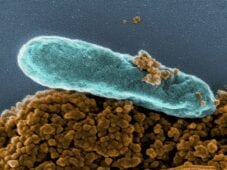
Researchers at ICFO have invented nano-optical tweezers capable of trapping and moving an individual nano-object in 3 dimensions using only the force of light
As science and technology go nano, scientists search for new tools to manipulate, observe and modify the “building blocks” of matter at the nanometer scale. With this in mind, the recent publication in Nature Nanotechnology in which ICFO researchers demonstrate for the first time the ability to use near-field optical tweezers to trap a nano-size object and manipulate it in the 3 dimensions of space, is an exciting achievement. Romain Quidant, ICREA Professor and leader at ICFO of the Plasmon Nano-Optics research group comments that “this technique could revolutionize the field of nanoscience since, for the first time, we have shown that it is possible to trap, 3D manipulate and release a single nano-object without exerting any mechanical contact or other invasive action”.
Imagine an elephant trying to grab an object the size of a needle with its gigantic hoof? Clearly this would be a tremendous if not impossible challenge because of the elephant’s enormous size in comparison to that of the needle. Now imagine that our needle is a single molecule or tiny object about the size of a few nanometers and we, with our conventional tools, need to trap it and manipulate it in in order to, for example, understand its implication in the development of a disease. We have the same problem, first because a conventional optical microscope is not capable of visualizing a single molecule and second, because the physical limitations of our conventional tweezers are simply not capable of grasping or manipulating such small objects.
Invented in Bell Labs in the 80’s, the original optical trapping demonstrated great capability to trap and manipulate small objects of micrometer size dimensions using laser light. By shining a laser light through a lens, it is possible to focus light in a tiny spot, creating an attractive force due to the gradient of the light intensity of the laser and thus attracting an object/specimen and maintaining it in the spot/focus.
While Optical tweezers have changed forever the fields of both biology and quantum optics, the technique has considerable limitations, one of which being its inability to directly trap objects smaller than a few hundreds of nanometers. This drawback prompted the pursuit of new approaches of nano-tweezers based on plasmonics, capable of trapping nano-scale objects such as proteins or nanoparticles without overheating and damaging the specimen. A few years ago, ICFO researchers demonstrated that, by focusing light on a very small gold nano-structure lying on a glass surface which acts as a nano-lens, one can trap a specimen at the vicinity of the metal where the light is concentrated. This proof of concept was limited to demonstrate the mechanism but did not enable any 3D manipulation needed for practical applications.
Now researchers at ICFO have taken this a crucial step further by implementing the concept of plasmonic nano-tweezers at the extremity of a mobile optical fiber, nano-engineered with a bowtie-like gold aperture. Using this approach, they have demonstrated trapping and 3D displacement of specimens as small as a few tens of nanometers using an extremely small, non-invasive laser intensity. Central to the great potential of this technique is that both trapping and monitoring of the trapped specimen can be done through the optical fiber, performing the manipulation of nano-objects in a simple and manageable way outside of the physics research lab.
This technique opens a plethora of new research directions requiring non-invasive manipulation of objects at the single molecule/virus level. It is potentially attractive in the field of medicine as a tool to further understand the biological mechanisms behind the development of diseases. Likewise, it holds promise in the context of nanotechnologies to assemble future miniature devices, among other exciting potential applications.
The Latest on: Control of nano-objects
[google_news title=”” keyword=”Control of nano-objects” num_posts=”10″ blurb_length=”0″ show_thumb=”left”]
via Google News
The Latest on: Control of nano-objects
- Hands on: iPad Pro 13-inch (2024): The impossibly thin king of iPads – and maybe all tabletson May 7, 2024 at 5:10 pm
Imagine a 13-inch iPad Pro that's a quarter-pound lighter than the last model, thinner than any gadget Apple has made before, packing completely new display technology, and powered by brand-new Apple ...
- 7 things you should know about the new M4 iPad Pro and M2 iPad Airon May 7, 2024 at 2:00 pm
New chips, better screens, and expanded sizes are just a few pieces of big news Apple announced today at its "Let Loose" event.
- Apple Event Live Blog: New iPad Pro, iPad Air, and Moreon May 7, 2024 at 6:34 am
Apple's "Let Loose" event kicks off today at the unusual time of 7:00 a.m. Pacific Time, and we're expecting to see an ...
- Canon EOS 90D w/ 18-135mm IS USM NANO Cameraon April 26, 2024 at 12:06 am
This SLR has 45 autofocus points, 17 exposure modes, and an exposure compensation control that can be set at +/-5 EV. The EOS 90D w/ 18-135mm IS USM NANO measures 5.6 inches wide by 4.1 inches ...
- New technological advance for fast and efficient 3D imaging of objectson April 11, 2024 at 8:46 am
Optical profilometry is a discipline that measures the three-dimensional profile of objects using light. "It is a crucial methodology in areas such as quality control in industrial processes or ...
- Angle-dependent holograms made possible by metasurfaceson February 21, 2024 at 10:16 am
The findings were published in Nano Letters. Objects can appear distinct depending ... Spin-Selective Angular Dispersion Control in Dielectric Metasurfaces for Multichannel Meta-Holographic ...
- Master in Nanoscience and Nanotechnologyon January 11, 2024 at 12:58 pm
Why do research in nano? Objects at the nanoscale are small enough that they have a lot more surface, relative to their volume, than macroscopic objects. At this scale we can start to see some hints ...
- Nanomaterials Informationon January 19, 2022 at 10:07 am
Currently, the best bottom-up approach is nano-manipulation which allows for precise control over single atoms and nanoscale ... gas or gasses into a chamber containing one or more heated objects to ...
- Nanotechnology in Spaceon August 18, 2020 at 12:13 pm
Nanotechnology has the potential to ... launch and most use them for attitude control as well (the control of the angular position and rotation of the spacecraft, either relative to the object that it ...
- How Does Nanotechnology Work?on August 17, 2020 at 12:25 pm
Nanotechnology is the understanding and control of matter at the nanometer scale ... the term nanoî= refers almost exclusively to particle length. This means that those objects that extend in two ...
via Bing News










